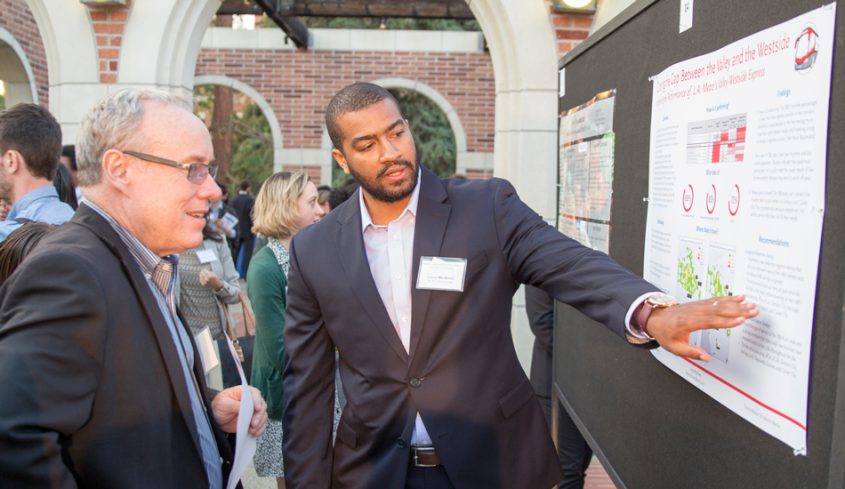
The ‘Perfect Place’ to Explore Urban Planning UCLA Luskin Master of Urban Planning students' research projects are showcased as part of a daylong welcome for admitted students
By Stan Paul
Are bike lanes making Angelenos safer? What elements make a street “grand” in L.A.? And, what exactly is a road diet, and should the City of Angels lose a few lanes?
These questions and others — from transportation planning and peak-hour parking restrictions to housing and pedestrian safety issues — were among the subjects of an annual UCLA Urban Planning tradition: Careers, Capstones and Conversations. Second-year students in the Master of Urban Planning (MURP) program showcased their research as the culmination of a daylong welcome for admitted Urban Planning graduate students at the UCLA Luskin School of Public Affairs.
The April 11 event, held at UCLA’s Fowler Museum, brought together Urban Planning faculty, students, incoming students and staff to get to know each other and learn more about the Urban Planning department and programs at Luskin. Each year, MURP second-year students are paired with faculty advisers and organizations representing industry, engineering, consulting firms and small entrepreneurial businesses, as well as local, regional and state agencies, educational institutions and nonprofit service organizations.
Lance MacNiven’s project, “Closing the Gap Between the Valley and Westside,” is a study of the performance of L.A. Metro’s Westside Express and how it might be improved to better serve potential riders. MacNiven’s faculty adviser is longtime Urban Planning professor and nationally known transportation planning expert Martin Wachs.
“He’s brilliant, I couldn’t ask for more in an adviser,” said MacNiven, who was kept busy explaining his project and fielding questions from clients, faculty and fellow urban planning students.
Wachs, viewing the projects, said he was impressed by the student displays, which are backed by their research and accompanying required reports. “They’re doing great,” said Wachs, who served as adviser for three other projects.
In addition to providing practice for each student to take on a real-world problem, collect data and analyze the information, the projects also provide the students with experience as planning consultants. The clients receive professional-level analysis and policy recommendations that can be implemented in planning decision-making.
MURP candidate Marissa Sanchez narrowed her focus to seven elements that go into making a “grand” street in Los Angeles. For Sanchez, who said her client was interested in improving ordinary streets, grand streets “enhance the local neighborhood physically, socially and economically by providing a safe place for users to connect, participate and engage their environment.” Sanchez’s research also concluded that grand streets “captivate residents, visitors, and all modes of users through pleasant qualities and characteristics that appeal to the various senses.”
Contrast that with the notion of a “road diet” in which streets/lanes are actually removed or displaced. Severin Martinez’s project, “Who Wins When Streets Lose Lanes?: Analyzing Safety on Road Diet Corridors in Los Angeles,” cited a Federal Highway Administration estimate that road diets actually reduce traffic collisions by almost 30 percent. Lane reductions are used to create improvements such as medians, street parking, bike lanes, center turn lanes and sidewalks.
In addition to road diets, food was also a topic of a number of the students’ projects. Food was addressed as “medicine” in terms of accessibility to patients in California as well as the benefits of urban agriculture in public housing sites. Also explored was the spatial distribution of food at UCLA, the purpose of which was to determine the accessibility of and provide recommendations for healthy food options on campus.
Worldwide, food security and sustainability are topics of increased interest so the Luskin School has become the administrative home of the UCLA Food Studies Graduate Certificate program, which is available to all UCLA graduate students.
With an initial interest in design, Casey Stern said after studying affordable housing for a few quarters, “I was hooked.” Her project focuses on secondary units in the city of Cudahy. Secondary units are also known as accessory dwelling units (ADUs), backyard cottages, in-law units, or the more familiar “granny flats.” However they are labeled, many are non-permitted, non-compliant with safety regulations, or just not legal by any means. Because of high housing demand and a large number of such non-permitted units, especially in L.A., Stern recommends that this city draft more permissive ordinances that, at the same time, would ensure safety and habitability among other supportive factors.
Admitted graduate student Ribeka Toda, who will join the program in the fall, is not new to UCLA. She completed her undergraduate degree in Civil Engineering and has a keen interest in transportation, which led her to seek out courses in urban planning at Luskin. Encouraged by professor Brian Taylor, who is director of Luskin’s Institute of Transportation Studies, Toda took graduate-level courses in transportation that further developed her interest the field.
“Civil engineering is the how of transportation … urban planning is the why,” said Toda. She added that planning provides options for people. She said exposure to “passionate grad students planted seeds” that led to her pursuing graduate study in planning. “Covering everything from parking to complete streets, this is the perfect place to explore these.”



Leave a Reply
Want to join the discussion?Feel free to contribute!